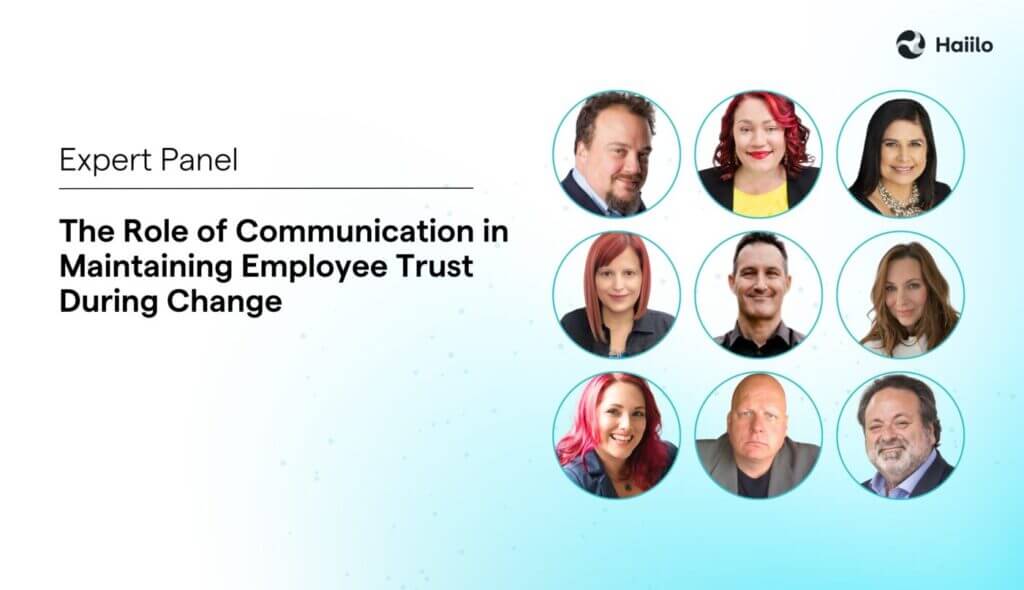Change is an inevitable force that impacts every aspect of our lives. It’s a constant, and organizations must evolve rapidly to stay ahead of the curve. Rapid advancements in technology are changing how we work and how organizations are structured, creating both opportunities and disruptions.
When organizational change is announced, employees often default to negative assumptions, fearing downsizing, layoffs, or upheaval. Yet, within this uncertainty, lies the opportunity for leaders to demonstrate their character and trustworthiness. Communication plays a vital role in this, and communication professionals are tasked with shaping narratives and facilitating dialogue, which is integral to ensuring transparent and authentic communication. By championing internal communication efforts, they engage employees and fortify their confidence in leadership and the organization’s vision.
Haiilo can help you build employee trust with multichannel communication and accessible channels for feedback and engagement.
Expert Panel: The Role of Communication in Maintaining Employee Trust During Change
To delve deeper into the connection between communication and employee trust during change, Haiilo turned to nine industry experts. Their insights shed light on how organizations can navigate challenges, embrace change, and foster employee trust during uncertainty.
Here’s what they shared with us.

Sia Papageorgiou, FRSA, FCSCE, SCMP
Managing Partner, Centre for Strategic Communication Excellence
The most effective leaders understand their critical role in the communication equation. Dr Martyn Newman, a psychologist and author of the book: “Emotional Capitalists: The New Leaders” describes leaders as the chief storytellers within their organizations – a sentiment that resonates deeply with me.
To earn employee trust, it’s important that leaders become a source of quality information and give people what they need. That includes role clarity, regular performance feedback,recognition, information about how the team is doing so that everyone is working towards a shared vision, ongoing information about the organization’s strategic foundations (purpose, vision, mission, values, and priorities), and line of sight to how they contribute to the organization’s success. It’s essential, then, that organizations employ leaders with the knowledge, skills, and experience to communicate effectively.
Great leaders listen and seek to understand their team members’ perspectives, concerns, and ideas, and they act on them – which demonstrates respect, encourages open and honest dialogue, and promotes a culture of trust and empathy. They create an environment where questions are welcomed, and people are encouraged to seek clarification when they don’t understand something. They also tell the truth and give people the whole picture– treating their employees like the adults they are.
They’re not just all talk; they walk the talk and, more importantly, don’t turn everything into their own show. As Simon Sinek says: “Leadership is not about being in charge: leadership is about taking care of those in your charge.” So, how are you demonstrating that your team is your top priority?
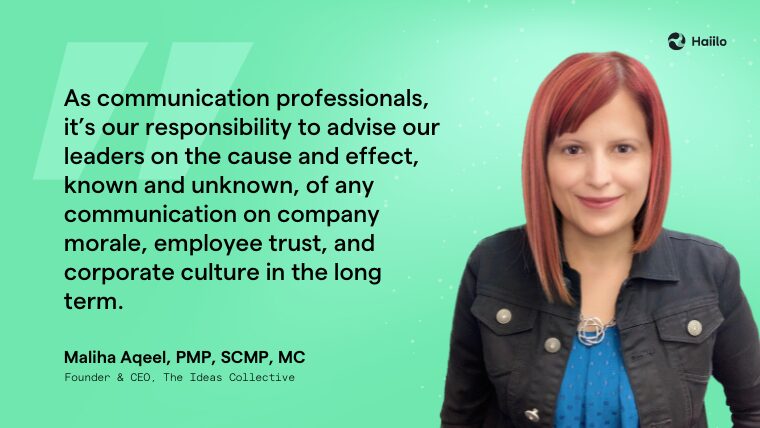
Maliha Aqeel, PMP, SCMP, MC
Founder & CEO, The Ideas Collective
One of the most important lessons I learned halfway through my communication career was that trust doesn’t just happen. It’s cultivated and earned through transparency, empathy, and consistency in how an organization aligns its actions and messages with the values it espouses. During times of change, uncertainty, and crisis, employees expect the organization’s leaders, from their direct manager upward, to provide assurance and understanding and to acknowledge there are real people on the other end who will be directly or indirectly impacted by any changes.
As communication professionals, it’s our responsibility to advise our leaders on the cause and effect, known and unknown, of any communication on company morale, employee trust, and corporate culture in the long term. We need to be the ‘Voice of Employee’ in The Room Where It Happens, literally; to thoughtfully communicate the ‘what,’ the ‘how,’ and the ‘why’ behind the organization’s decisions and reinforce our commitment to their well-being and our shared values. This authenticity is what builds employee trust.
We’ve all seen headlines where internal emails and meeting recordings were shared on media and social channels. Any internal communication should be developed from the perspective that it can and will be shared outside the organization. Plan accordingly!
📚Keep reading: 8 Tips to Boost Employee Communications At Your Company
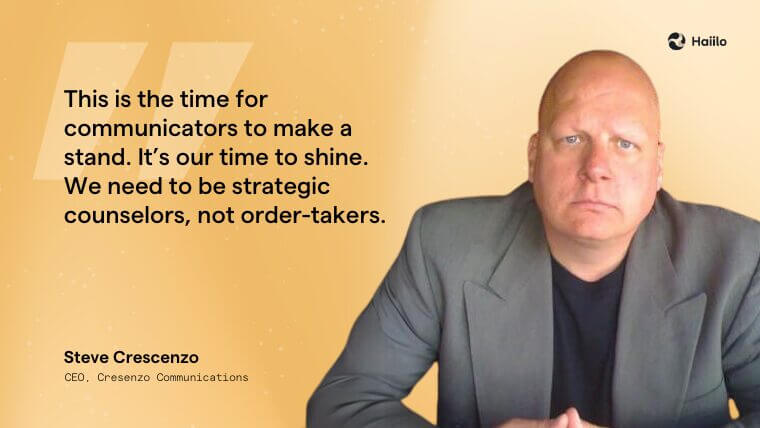
Steve Crescenzo
CEO, Cresenzo Communications
I think COVID changed employee communications forever. Whether that becomes a positive or negative change remains to be seen.
During COVID, companies and leaders were forced to get better at communication. All the things communicators have been preaching for years—more timely communication; more conversational, less formal voice and tone; more transparency; more human communication; more two-way communication—all happened during Covid, out of necessity.
Organizations had to move fast. They had to listen more to employee concerns. They had to be transparent about not having all the answers. They had to be more human.
Now, some organizations and leaders are backsliding to the “old” way. The “corporate” way. We are seeing it at so many organizations, especially the ones trying to navigate the challenges of a hybrid workforce.
This is the time for communicators to make a stand. It’s our time to shine. We need to be strategic counselors, not order-takers. The communicators (and organizations) who lean into this will determine the future of employee communications for years to come.
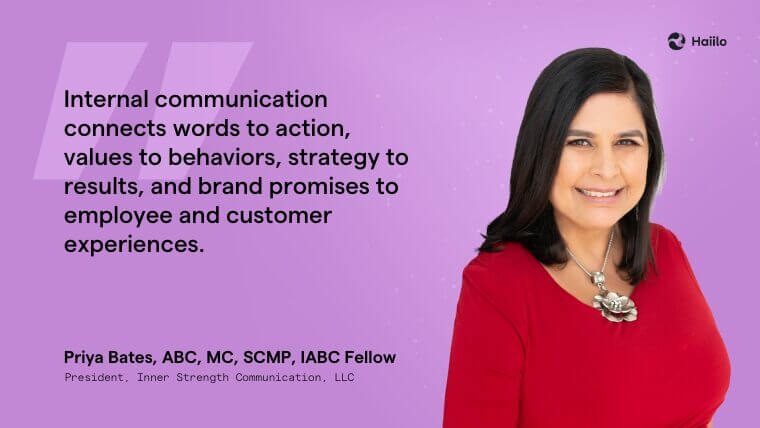
Priya Bates, ABC, MC, SCMP, IABC Fellow
President, Inner Strength Communication Inc.
CHANGE as an OPPORTUNITY to engage and build trust.
Many see change as a great disruptor. They believe that when things change, we expect to experience loss, sorrow, despair, or disengagement. But what if the opposite were true? Think about it. Do we learn to trust others when everything is great and going smoothly, or do we learn to trust because we have connected and understood one another during challenges and our ability to stick together and support one another during the tough times?
As the world continues to be divided on geopolitical, cultural, and socioeconomic lines, it’s important that we focus on authentic and honest conversations that meet people where they are and acknowledge differences as an advantage that brings people together.
In my career, I have worked with employers and clients navigating transformational change, including restructuring, mergers & acquisitions, digital transformations, and changes in competitive and economic environments. It’s in our ability to bring people together. To believe in their potential. To create alignment and work together to fight for one another –colleagues, community, and customers – we can use change to accomplish great things and connect our employees to the cause. Internal communication connects words to action, values to behaviors, strategy to results, and brand promises to employee and customer experiences. It is in this connection that we fill a gap that connects heads, hands, and hearts to accomplish great things together.
💡Want more insights? Check out Belonging is All About Trust
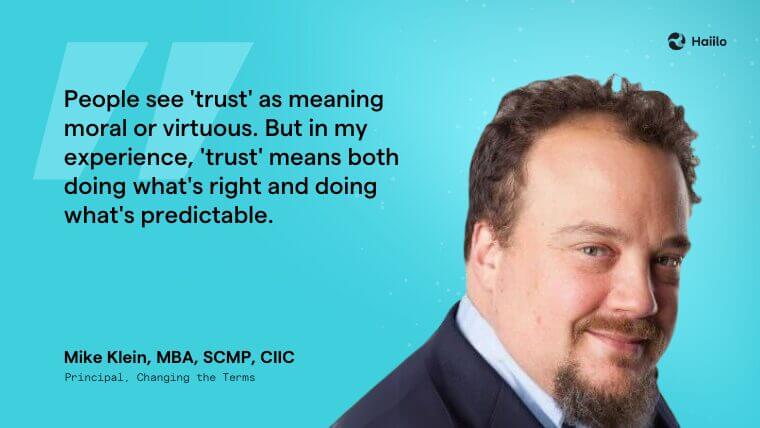
Mike Klein, MBA, SCMP, CIIC
Principal, Changing the Terms
The most important thing is to avoid overpromising and underdelivering.
There’s a lot of talk about ‘people-centric culture‘ and ‘psychological safety‘ at the moment. The real question is how far you’re prepared to walk that talk. Over time, a company will encounter economic, cultural, or market turbulence. If you talk a good game and you don’t carry it through the turbulence, you may well be cooked.
People see ‘trust’ as meaning moral or virtuous. But in my experience, ‘trust’ means both doing what’s right and doing what’s predictable. Without that foundation of predictability, one’s intention to do the right thing doesn’t spark much confidence, and when that predictability is broken, it becomes slow and difficult to repair.
The most important thing is to be clear that you are doing more than the minimum and, ideally, substantially more than the minimum, especially when it comes to layoffs. And if you can add an element of choice in terms of staying or leaving – even if it means some talented people you want to keep decide to take the money and run – your culture will be in much better shape when the current round is over.
Minimizing the gap between walk and talk is always a good idea. But when it comes to M&A, failing to do so can actually be fatal. It’s the first time your acquired employees are seeing you in action, and the uncertainties around jobs and status among your existing employees mean that you can’t assume that the goodwill you’ve built with them is still intact. If employees see that the new organization is going to break its promises, those who can quickly break their ties, leaving little of value remaining.
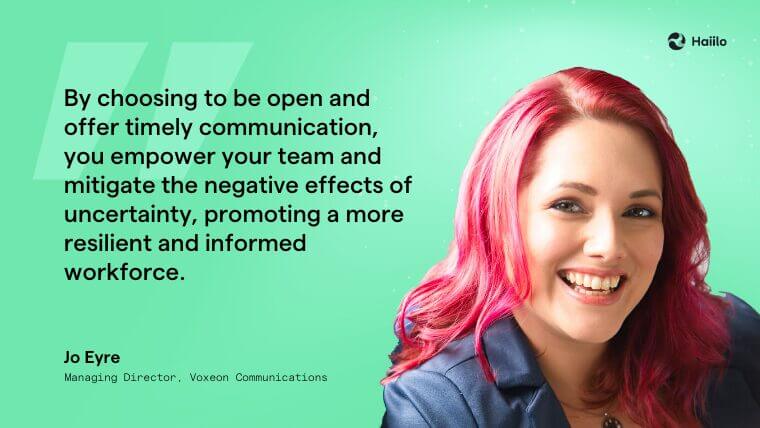
Jo Eyre
Managing Director, Voxeon Communications
In times of company disruptions and challenges, shock is often preferable to uncertainty. While it may initially catch your team off guard, choosing to be transparent and share information promptly demonstrates a profound trust in your team’s ability to handle the situation with professionalism. This act of transparency is likely to be reciprocated, strengthening the bond of trust within the team.
On the contrary, uncertainty tends to breed stress on an individual level and fuel the rumor mill collectively. It typically arises when employees sense that changes are in the air, but leadership lacks transparency or proactive communication. By choosing to be open and offer timely communication, you empower your team and mitigate the negative effects of uncertainty, promoting a more resilient and informed workforce.
🧐 Check out Why Your Communications Fall Flat: Connecting Your Internal Audience with Business Objectives
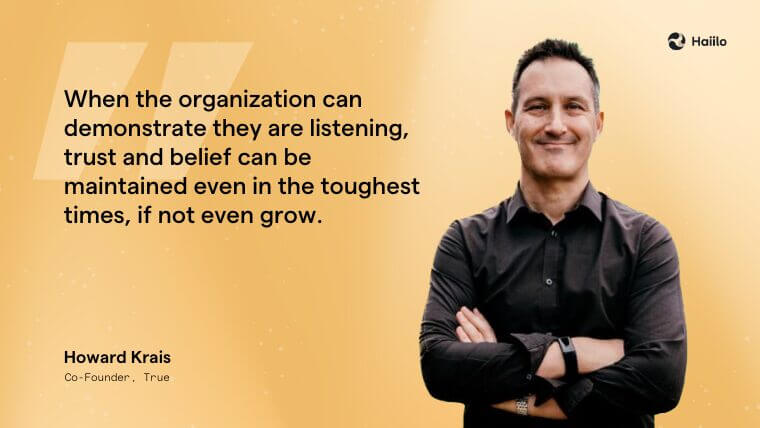
Howard Krais
Co-Founder, True
When big, sometimes painful change is required, engage your employees as early as possible. Talk to those leaving with respect, but make sure you talk more to those staying. Explain what the changes are, why they are important, and how they will help the business be successful. Share an honest vision of how things will look once the changes have happened. Critically do all this in an empathetic and supportive manner.
Your employees are smarter than you think. They know what is happening around them. They see production lines no longer working 24-7. They speak every day to customers, suppliers, or friends in other companies so they understand what is really happening in the market.
Provide your people with space and time to have conversations about what the change is likely to mean for them and encourage them to consider how they can contribute to the change. Critically, listen to their views, and respond. Get answers to their questions promptly and look for every opportunity to continue the conversation.
Employees recognize that businesses go through tough times. When the organization can demonstrate they are listening, trust and belief can be maintained even in the toughest times, if not even grow.
➡️ Read on: We know it but we don’t do it: Creating the people-centric approach to change

Shel Holtz, SCMP
Sr. Director, Communications, Webcor
When employees trust leaders, it means they believe leaders will do the right thing and that their actions will match their words. Disruptions, from layoffs to acquisitions and other turmoil, are going to happen. If leaders lose the trust of their workforce, it is not because they happened but because leaders didn’t pass the integrity test.
Candor, authenticity, and vulnerability can perform a lot of heavy lifting during these periods. Communicators should counsel their leaders or clients never to lie or twist the truth. If they are unable to share information, they should explain why and let employees know when they will be free to fill everyone in. Answering employee questions and communicating regularly are always important leadership responsibilities, but the importance of these activities intensifies during times of disruption.
Always remember, employees don’t have to like the change that’s occurring. There is no way to make employees happy about a layoff. But employee trust will remain high if they understand what’s happening, the reasons for it, and what they can expect in the days, weeks, or months ahead.

Natasha Nicholson
Content Marketing, Communication, and Brand Strategist, Traliant
We’re living in a volatile time, experiencing serious global events and economic ups and downs. It leaves us wondering about what’s coming next. And the feeling of uncertainty that goes with it creates a sweeping undercurrent that can impact our decisions and our choices and affect the very culture of our organizations. It can stifle creativity, push back innovation, and crush morale. But none of that has to happen.
There is a way to rise above pending turmoil and keep our organizations resilient, no matter what’s ahead. We can help our organizations and our employees to not only survive but thrive—even in the face of uncertainty. The answer lies in our ability to build and maintain a culture of inclusivity where all employees feel safe, respected, and appreciated—and where awareness, empathy, and transparency lead the way.
See this article from Traliant to learn how inclusivity supports organizations through change, mitigates risk—and discover five building blocks for achieving inclusive leadership under pressure.
🤝 Want even more expert guidance? Check out Haiilo CEO Roope Heinilä’s thoughts on The Role of CEO Communications In Driving Business Success
Creating a Culture of Trust
Each expert shared a unique perspective and wealth of experience, offering invaluable insights into the complex interplay between communication and trust during times of change.
Building employee trust within an organization requires a systematic approach incorporating transparency, active listening, timely communication, accountability, and empathy. Here’s how you can implement these strategies effectively:
Transparency:
- Provide regular updates on organizational changes, including the reasons behind them and their potential impact on employees.
- Encourage open dialogue and feedback sessions where employees can freely ask questions and express concerns.
- Lead by example by being honest and transparent in your communications, even when delivering difficult news.
Example: In addition to leveraging a multichannel communication platform to better ensure all employees receive updates, consider implementing monthly town hall meetings where senior leaders share updates on company performance, upcoming initiatives, and challenges faced.
✅ Learn more: What is Multichannel Communication and How to Get It Right
Active Listening:
- Actively listen to employee feedback and concerns without judgment or defensiveness.
- Demonstrate empathy by acknowledging and validating employees’ feelings and experiences.
- Follow up on feedback received and take concrete actions to address issues raised by employees.
Example: Send engagement surveys where employees can anonymously provide feedback. Regularly review and respond to the questions and comments received, highlighting any actions taken.
Timely Communication:
- Communicate changes and updates promptly to keep employees informed and minimize uncertainty.
- Be proactive in addressing questions and concerns raised by employees, providing timely responses and updates as needed.
- Set clear expectations regarding communication channels and response times to ensure consistency and reliability.
Example: Develop a communication strategy outlining the process for distributing important information within the organization. Specify who is responsible for communicating updates, the preferred communication channels to be used, and the expected timeline for response.
🔎 Check out 18 Leadership Communication Trends to Look For in 2024
Accountability:
- Hold leaders and team members accountable for their actions and decisions, ensuring alignment with organizational values and goals.
- Admit mistakes openly and take responsibility for rectifying them, demonstrating integrity and trustworthiness.
- Establish a culture of continuous improvement by encouraging feedback and learning from past experiences.
Example: Talk about it when things don’t go according to plan. Have a conversation with employees where they understand why the decision is made and how it will be resolved, and allow them to ask questions and voice concerns.
Empathy:
- Demonstrate empathy towards employees’ concerns and experiences, recognizing the impact of change on their well-being.
- Create opportunities for employees to share their stories and experiences, establishing a sense of connection and belonging.
- Provide support and resources to help employees navigate challenges and cope with stress during times of change.
Example: Establish employee communities or wellness programs promoting mental health and resilience. Offer workshops or training sessions on topics such as stress management and work-life balance to equip employees with coping strategies.
By implementing these trust-building strategies systematically and consistently, organizations can foster a culture of trust, transparency, and collaboration, laying the foundation for long-term success and resilience.


